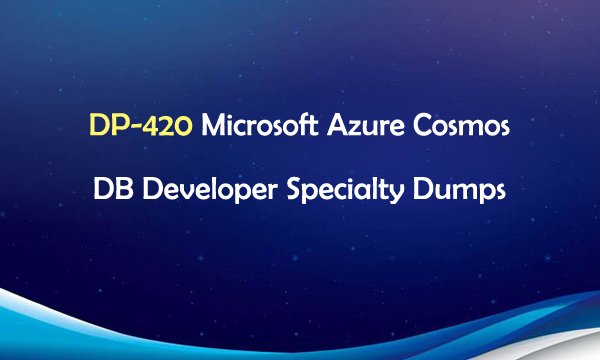DP-420 Microsoft Azure Cosmos DB Developer Specialty Dumps
January 13,2022 04:01 AM
Microsoft DP-420 exam is a required test for Microsoft Certified: Azure Cosmos DB Developer Specialty certification. Candidates for this certification must have solid knowledge and experience developing apps for Azure and working with Azure Cosmos DB database technologies. To get certification, you should have subject matter expertise designing, implementing, and monitoring cloud-native applications that store and manage data. Designing and Implementing Cloud-Native Applications Using Microsoft Azure Cosmos DB DP-420 dumps are available.

Microsoft DP-420 Exam
Designing and Implementing Cloud-Native Applications Using Microsoft Azure Cosmos DB DP-420 exam basic information is helpful in your preparation. The required passing score of Microsoft certification DP-420 exam is 700. The available language is English. Each DP-420 candidate can register Microsoft Azure Cosmos DB Developer Specialty DP-420 exam at Pearson VUE test center, and the registration fee is $165.
Microsoft Azure Cosmos DB Developer Specialty DP-420 Exam Skills
Microsoft Azure Cosmos DB Developer Specialty DP-420 exam skills cover the following details.
Design and implement data models (35–40%)
Design and implement data distribution (5–10%)
Integrate an Azure Cosmos DB solution (5–10%)
Optimize an Azure Cosmos DB solution (15–20%)
Maintain an Azure Cosmos DB solution (25–30%)
Practice Microsoft DP-420 Exam Dumps Questions
All the latest Microsoft certification DP-420 exam dumps questions can help you study the above Designing and Implementing Cloud-Native Applications Using Microsoft Azure Cosmos DB DP-420 skills. Share some Microsoft DP-420 exam dumps questions below.
1.You configure multi-region writes for account1. You need to ensure that App1 supports the new configuration for account1. The solution must meet the business requirements and the product catalog requirements. What should you do?
A. Create a private endpoint connection.
B. Increase the number of request units per second (RU/s) allocated to the con-product and conproductVendor containers.
C. Modify the connection policy of App1.
D. Set the default consistency level of accountl to bounded staleness.
Answer: B
2.You need to select the partition key for con-iot1. The solution must meet the IoT telemetry requirements. What should you select?
A. the temperature
B. the timestamp
C. the device ID
D. the humidity
Answer: C
3.You have a database in an Azure Cosmos DB Core (SQL) API account. The database is backed up every two hours. You need to implement a solution that supports point-in-time restore. What should you do first?
A. Configure the Point In Time Restore settings for the account.
B. Enable Continuous Backup for the account.
C. Configure the Backup & Restore settings for the account.
D. Create a new account that has a periodic backup policy.
Answer: B
4.Note: This question is part of a series of questions that present the same scenario. Each question in the series contains a unique solution that might meet the stated goals. Some question sets might have more than one correct solution, while others might not have a correct solution. After you answer a question in this section, you will NOT be able to return to it. As a result, these
questions will not appear in the review screen. You have an Azure Cosmos DB Core (SQL) API account named account 1 that uses autoscale throughput. You need to run an Azure function when the normalized request units per second for a container in
account1 exceeds a specific value.
Solution: You configure an Azure Monitor alert to trigger the function.
Does this meet the goal?
A. No
B. Yes
Answer: B
DP-420 Exam Dumps PDF & SOFT | 1 Year Free Update | Money Back Guarantee
- Related Suggestion
- How to Achieve the CP1 Cathodic Protection Tester Certification? December 22,2023
- CFPS Certified Fire Protection Specialist Exam Dumps Available November 13,2023
- Microsoft: Innovations and Certifications in 2023 April 12,2023
- Best Approach to Pass AZ-400 Exam March 05,2019
- Microsoft SQL Server 2016 Certification Updates: Guides and Exam Dumps January 06,2018

